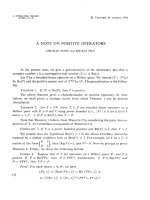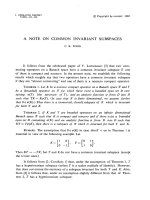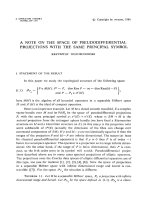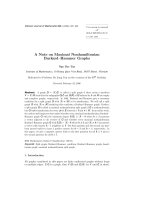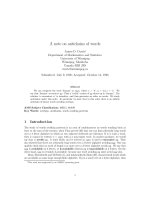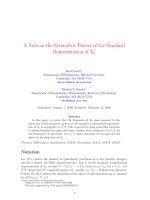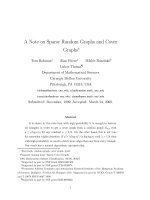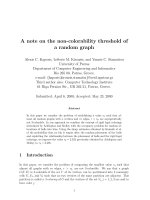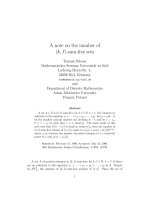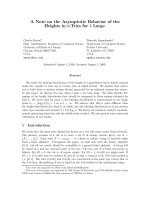Báo cáo toán học: "A Note on Two Multicolor Ramsey Number" doc
Bạn đang xem bản rút gọn của tài liệu. Xem và tải ngay bản đầy đủ của tài liệu tại đây (63.39 KB, 3 trang )
A Note on Two Multicolor Ramsey Numbers
Alexander Engstr¨om
∗
Institute of Theoretical Computer Science
ETH Z¨urich, Z¨urich, Switzerland
Submitted: May 3, 2005; Accepted: Aug 19, 2005; Published: Aug 30, 2005
Mathematics Subject Classifications: 05C55
Abstract
Two new bounds for multicolor Ramsey numbers are proved:
R(K
3
,K
3
,C
4
,C
4
) ≥ 27 and R
4
(C
4
) ≤ 19.
1 Introduction
We prove two new bounds for multicolor Ramsey numbers, a lower bound for
R(K
3
,K
3
,C
4
,C
4
) by coloring K
26
, and an upper bound for R
4
(C
4
) by a density argu-
ment.
2 The Ramsey number R(K
3
,K
3
,C
4
,C
4
)
From the survey of Ramsey numbers by Radziszowski [3] we know that
R(K
3
,K
3
,C
4
,C
4
) ≥ 26. We use C
5
-decompositions to construct a four-coloring of the
edges of K
26
,whichshowthatR(K
3
,K
3
,C
4
,C
4
) ≥ 27. The technique used in this section
was invented by Exoo and Reynolds [2].
Theorem 1 R(K
3
,K
3
,C
4
,C
4
) ≥ 27.
Proof: Let X, Y , I,
¯
0, and
¯
1 be defined by
X =
01001
10100
01010
00101
10010
Y =
00110
00011
10001
11000
01100
I =
10000
01000
00100
00010
00001
¯
0=
0
0
0
0
0
¯
1=
1
1
1
1
1
∗
Research supported by ETH and Swiss National Science Foundation Grant PP002-102738/1
the electronic journal of combinatorics 12 (2005), #N14 1
The critical colorings which show that R(K
3
,K
3
) > 5andR(C
4
,C
4
) > 5havethe
adjacency matrices X and Y .ObservethatX + Y + I is the all-ones 5 × 5 matrix.
We now construct four 26 × 26 adjacency matrices M
i
,sothatM
1
and M
2
contain no
K
3
,andM
3
and M
4
contain no C
4
.
Given a triangle-free graph on n vertices, one can construct a triangle-free graph on
nm vertices by replacing each vertex with m vertices and each edge with K
m,m
.We
construct the two first graphs, which are isomorphic, by beginning with C
5
, replacing the
edges with K
5,5
− e, and then adding a vertex with five edges.
M
1
=
0 XXXX
¯
1
XXXXX
¯
0
XXXXX
¯
0
XXXXX
¯
0
XXXXX
¯
0
¯
1
T
¯
0
T
¯
0
T
¯
0
T
¯
0
T
0
M
2
=
YYYYY
¯
0
YYYYY
¯
0
YYYYY
¯
0
YYYYY
¯
0
YYYY 0
¯
1
¯
0
T
¯
0
T
¯
0
T
¯
0
T
¯
1
T
0
11
6
1
16
21
2
12
17
22
7
3
8
13
18
2
3
4
9
14
19
24
5
10
15
20
25
26
21
16
11
6
1
9
14
19
24
22
17
12
7
2
25
20
15
10
5
23
18
13
8
3
4
26
Figure 1: The graphs with adjacency matrices M
1
and M
2
.
We denote the vertices from the top of the matrices as 1, 2, 26. The graphs are
showninFigure1. Vertices1−25 are the triangle-free constructions from C
5
and K
5,5
−e.
Vertex 26 is in no triangle, since its neighbors have no edges between them. Hence, the
graphs are triangle-free.
The remaining edges are distributed as described by the adjacency matrices M
3
and
M
4
.
M
3
=
XI 00I
¯
0
I 0 I 00
¯
0
0 I 0 I 0
¯
1
00I 0 I
¯
1
I 00I 0
¯
0
¯
0
T
¯
0
T
¯
1
T
¯
1
T
¯
0
T
0
M
4
=
00II0
¯
0
000II
¯
1
I 000I
¯
0
II000
¯
0
0 II0 Y
¯
0
¯
0
T
¯
1
T
¯
0
T
¯
0
T
¯
0
T
0
the electronic journal of combinatorics 12 (2005), #N14 2
24
19
14
9
4
5
20
25
10
15
1611
21
6
1
2
17
22
12
7
18
13
8
23
3
26
16
1
11
21
3
13
8
18
6
23
10
20
5
15
25
7
17
2
12
22
19
9
4
14
24
26
Figure 2: The graphs with adjacency matrices M
3
and M
4
.
It is not hard to see that M
1
+ M
2
+ M
3
+ M
4
is the adjacency matrix of K
26
.Itis
clear from Figure 2 that there are no quadrilaterals.
3 The Ramsey number R
4
(C
4
)
From the Ramsey number survey [3] we also know that 18 ≤ R
4
(C
4
) ≤ 21. It was shown
by Clapham, Flockhart and Sheehan [1] that a C
4
-free graph with 19 vertices has at most
42 edges. Since 4 · 42 = 168 and there are 171 edges in K
19
, it is not possible to four-color
the edges of K
19
without a monochromatic quadrilateral.
Theorem 2 R
4
(C
4
) ≤ 19.
References
[1] C.R.J. Clapham, A. Flockhart, J. Sheehan, Graphs without four-cycles, J. Graph
Theory, 13 (1989) 29–47.
[2] G. Exoo, D.F. Reynolds, Ramsey numbers based on C
5
-decompositions, Discrete
Math., 71 (1988) 119–127.
[3] S. Radziszowski, Small Ramsey numbers, Electron. J. Combin., DS1 (revision #9,
2002).
the electronic journal of combinatorics 12 (2005), #N14 3
